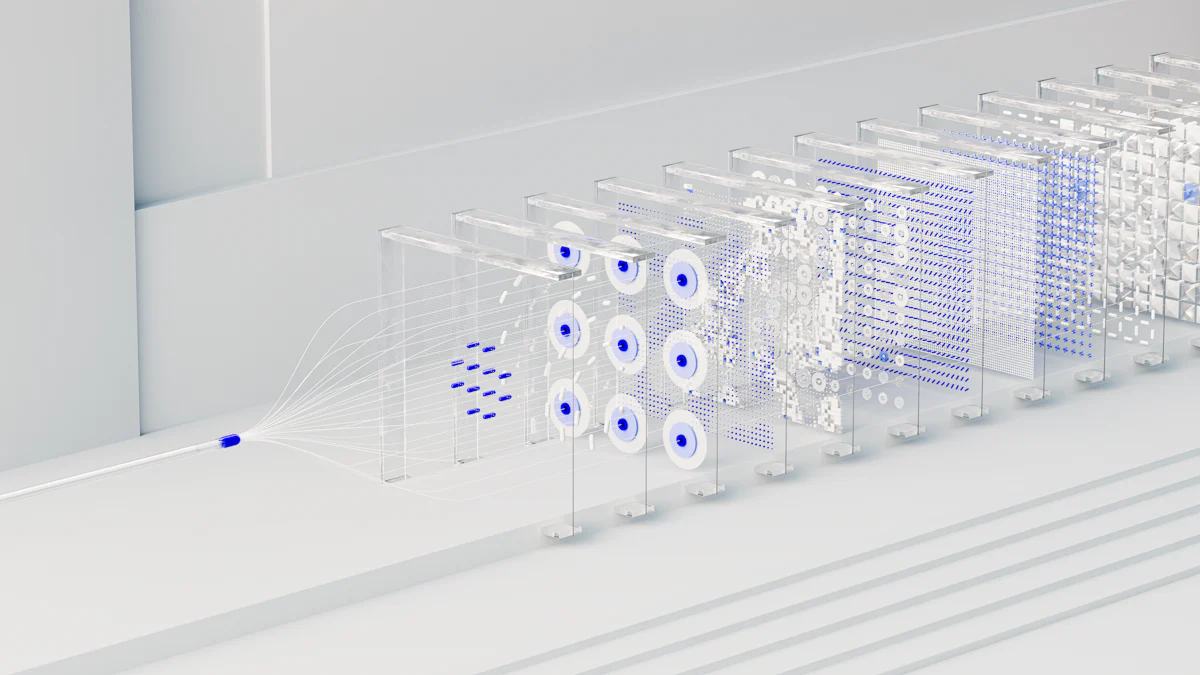DeepSeek V3 vs GPT-4 and Llama 3.1 - A Comprehensive Comparison

Choosing the right AI model can transform how you solve problems or automate tasks. Each model, whether it’s the DeepSeek model, GPT-4, or Llama 3.1, offers unique strengths. Understanding these differences helps you make informed decisions. For example, finding differences in their capabilities ensures you select the best fit for your needs. Whether you need advanced natural language processing or multilingual support, knowing what each model excels at saves time and resources.
Model Overview
Release Dates and Background
Understanding the release history of these models helps you grasp their evolution. Deepseek-v3 launched in early 2023, building on the success of its predecessor, the deepseek model. It introduced significant upgrades in natural language processing and multilingual capabilities. GPT-4o, including its variants like gpt-4 0314 and gpt-4 turbo, debuted in mid-2023. These versions focused on improving efficiency and expanding the input context window. Llama 3.1, released in late 2023, aimed to refine its open-source framework while enhancing performance benchmarks. Each model reflects advancements in AI, offering unique strengths for different applications.
Key Features of DeepSeek V3, GPT-4, and Llama 3.1
Input Context Window
The input context window determines how much information the model can process at once. Deepseek-v3 supports a context window of 16,000 tokens, making it ideal for tasks requiring extensive data. GPT-4o, including gpt-4 turbo and gpt-4 0314, offers a slightly smaller window of 8,000 tokens. Llama 3.1 provides a flexible range, with options extending up to 32,000 tokens for advanced use cases. These differences impact how you approach tasks like summarization or content creation.
Maximum Output Tokens
Output token limits define how much text the model can generate in one response. Deepseek-v3 allows up to 4,000 tokens, balancing length and coherence. GPT-4o variants, such as gpt-4 turbo, cap outputs at 6,000 tokens, offering more flexibility for longer responses. Llama 3.1 leads with a maximum of 8,000 tokens, making it suitable for detailed reports or creative writing.
Open-Source Status
Open-source models provide greater customization. Llama 3.1 stands out as fully open-source, enabling developers to modify and deploy it freely. Deepseek-v3 and gpt-4o, including gpt-4 turbo, remain proprietary, focusing on controlled environments for enhanced security and reliability. Your choice depends on whether you prioritize customization or stability.
Supported Languages and Multilingual Capabilities
Language support plays a crucial role in global applications. Deepseek-v3 supports over 50 languages, excelling in multilingual tasks. GPT-4o variants, such as gpt-4 0314, cover a similar range but emphasize high-quality translations. Llama 3.1 supports fewer languages but offers deep integration for niche linguistic needs. These capabilities make each model suitable for specific multilingual scenarios.
Accessibility and Deployment Options
When choosing an AI model, accessibility and deployment options play a critical role. These factors determine how easily you can integrate the model into your workflows and whether it aligns with your technical requirements.
Deployment Flexibility
Each model offers unique deployment methods. DeepSeek V3 provides a cloud-based platform, making it accessible from anywhere with an internet connection. This option suits businesses that prioritize ease of use and minimal setup. GPT-4o, including its variants like GPT-4 Turbo, also operates primarily through cloud APIs. OpenAI ensures seamless integration with popular tools and platforms, which simplifies adoption for developers. On the other hand, Llama 3.1 stands out with its on-premise deployment capabilities. You can host it locally, giving you full control over data and infrastructure. This feature makes it ideal for organizations with strict data privacy policies.
Hardware Requirements
Hardware compatibility affects how you deploy these models. DeepSeek V3 and GPT-4o require minimal hardware investment since they run on cloud servers. You only need a stable internet connection to access their features. Llama 3.1, however, demands more robust hardware for local deployment. You may need high-performance GPUs to achieve optimal performance. If you lack the necessary infrastructure, this could increase your initial costs.
Tip: If you value data security or need offline access, consider Llama 3.1. For quick and scalable solutions, cloud-based models like DeepSeek V3 or GPT-4o are better options.
User Accessibility
User accessibility varies across these models. DeepSeek V3 and GPT-4o offer intuitive interfaces and detailed documentation. These features make them beginner-friendly. Llama 3.1, while powerful, requires more technical expertise for setup and customization. If you’re a developer or researcher, you’ll appreciate its flexibility. For small businesses or non-technical users, cloud-based models provide a smoother experience.
Model | Deployment Type | Hardware Needs | Best For |
|---|---|---|---|
DeepSeek V3 | Cloud-based | Minimal | Small businesses, enterprises |
GPT-4o | Cloud-based | Minimal | Developers, enterprises |
Llama 3.1 | On-premise/cloud | High-performance GPUs | Researchers, privacy-focused |
Understanding these options helps you select a model that fits your needs and resources.
Pricing Comparison
Cost Structures of DeepSeek V3, GPT-4, and Llama 3.1
Subscription Plans
Subscription plans are a common pricing model for AI tools. Deepseek-v3 offers tiered plans based on usage. These plans cater to small businesses and enterprises. GPT-4o, including gpt-4 turbo and gpt-4 0314, follows a similar structure. OpenAI provides flexible options, allowing you to scale as your needs grow. Llama 3.1, however, does not rely on traditional subscription models. Instead, it focuses on its open-source nature, which eliminates recurring fees. This makes it a cost-effective choice for developers with technical expertise.
Pay-as-You-Go Options
Pay-as-you-go pricing provides flexibility for users with unpredictable workloads. Deepseek-v3 supports this model, charging based on the number of tokens processed. GPT-4o, including gpt-4 turbo and gpt-4 0314, also offers pay-as-you-go plans. These plans are ideal for developers who need occasional access to advanced AI capabilities. Llama 3.1, being open-source, does not charge for usage. However, you may incur costs for hosting and maintaining the model on your infrastructure.
Free Tier Availability
Free tiers allow you to test AI models without financial commitment. Deepseek-v3 includes a limited free tier, suitable for small-scale experiments. GPT-4o, including gpt-4 turbo, provides a similar option. This tier helps you explore its capabilities before committing to a paid plan. Llama 3.1, as an open-source model, is inherently free. You can download and use it without restrictions, though hardware costs may apply.
Value for Money
When evaluating value for money, consider your specific needs. Deepseek-v3 balances cost and performance, making it a strong choice for businesses. GPT-4o, including gpt-4 turbo and gpt-4 0314, offers advanced features at a competitive price. Llama 3.1 stands out for its zero-cost licensing, though it requires technical expertise. Finding differences in cost structures helps you choose the best model for your budget and goals.
Note: If you prioritize affordability and customization, Llama 3.1 is a great option. For scalable and user-friendly solutions, deepseek-v3 and gpt-4o are better suited.
Performance Analysis

Benchmark Results for DeepSeek V3, GPT-4, and Llama 3.1
Natural Language Understanding
Natural language understanding tests how well a model processes and interprets human language. Deepseek-v3 excels in this area, achieving high scores on the mmlu-pro benchmark. This makes it reliable for tasks like sentiment analysis and language translation. GPT-4o, including gpt-4 0314 and gpt-4 turbo, also performs exceptionally well, with a slight edge in accuracy for complex queries. Llama 3.1, while strong, lags behind in certain multilingual benchmarks. However, its open-source nature allows you to fine-tune it for specific needs, which can improve its results.
Code Generation
Code generation evaluates how effectively a model writes or completes code. Deepseek-v3 demonstrates consistent performance, especially in generating Python and JavaScript code. GPT-4o, particularly gpt-4 turbo, outshines others in this category. It provides detailed explanations alongside code, which helps developers debug or learn. Llama 3.1 shows promise but requires additional customization to match the output quality of its competitors.
Creative Writing
Creative writing tasks test a model’s ability to generate engaging and coherent content. Deepseek-v3 produces well-structured narratives, making it suitable for blog writing or storytelling. GPT-4 0314 and gpt-4 turbo deliver more imaginative and nuanced outputs, which are ideal for poetry or fiction. Llama 3.1, while capable, often struggles with maintaining coherence in longer pieces. Its strength lies in shorter, focused creative tasks.
Real-World Task Comparisons
Customer Support Automation
Deepseek-v3 handles customer queries with precision, offering accurate and context-aware responses. GPT-4o, including gpt-4 turbo, provides faster response times and excels in understanding complex customer issues. Llama 3.1, though effective, requires more effort to integrate into customer support systems.
Content Creation
For content creation, deepseek-v3 balances quality and speed. It generates clear and concise articles. GPT-4 0314 and gpt-4 turbo produce richer and more detailed content, which suits professional writers. Llama 3.1 works best for niche topics, where customization is key.
Data Analysis and Summarization
Deepseek-v3 simplifies data analysis by summarizing large datasets effectively. GPT-4o, especially gpt-4 turbo, provides more detailed insights and explanations. Llama 3.1, while capable, requires additional tuning to match the analytical depth of its counterparts.
Model Limitations and Trade-offs
Each model has trade-offs. Deepseek-v3 offers balanced performance but lacks the customization of llama 3.1. GPT-4o, including gpt-4 0314 and gpt-4 turbo, excels in advanced tasks but comes with higher costs. Llama 3.1 provides flexibility but demands technical expertise. Understanding these differences helps you choose the right model for your needs.
Note: If you prioritize ease of use, deepseek-v3 is a strong choice. For advanced capabilities, gpt-4o stands out. If you need customization, llama 3.1 offers unmatched flexibility.
Use-Case Suitability

Best for Enterprises
If you manage an enterprise, you need an AI model that handles large-scale tasks efficiently. Deepseek-v3 offers a robust solution for enterprises. Its cloud-based deployment ensures scalability, while its 16,000-token input context window supports complex workflows like summarizing lengthy reports or analyzing extensive datasets. You can rely on its multilingual capabilities to serve global audiences. GPT-4o, including gpt-4 turbo and gpt-4 0314, also fits enterprise needs. It excels in advanced natural language understanding and creative writing, making it ideal for tasks like drafting marketing materials or automating customer support. Llama 3.1, with its on-premise deployment, suits enterprises prioritizing data privacy. However, its hardware requirements may increase costs.
Best for Developers and Researchers
Developers and researchers often need flexibility and customization. Llama 3.1 stands out in this category. Its open-source nature allows you to fine-tune the model for specific projects. If you have the technical expertise, you can modify its architecture to suit niche applications. GPT-4o, including gpt-4 turbo and gpt-4 0314, offers a balance of power and ease of use. Its detailed documentation and API integration simplify development tasks. Deepseek-v3 provides a user-friendly interface, making it accessible for developers who prefer minimal setup. While it lacks the customization of llama 3.1, it delivers consistent performance across various tasks.
Best for Small Businesses and Individual Users
Small businesses and individual users often prioritize ease of use and affordability. Deepseek-v3 shines in this area. Its intuitive interface and pay-as-you-go pricing make it accessible for users with limited budgets. You can use it for tasks like content creation or automating customer interactions. GPT-4o, including gpt-4 turbo and gpt-4 0314, offers similar benefits but at a higher cost. Its advanced features may appeal to users seeking premium capabilities. Llama 3.1, while free to use, requires technical expertise for setup. If you lack the necessary skills or infrastructure, it may not be the best choice.
Tip: For enterprises, deepseek-v3 and gpt-4o provide scalable solutions. Developers and researchers benefit most from llama 3.1’s flexibility. Small businesses should consider deepseek-v3 for its affordability and simplicity.
Niche Applications
AI models often shine in niche applications where specific capabilities are required. Deepseek-v3, gpt-4o (including gpt-4 turbo and gpt-4 0314), and llama 3.1 each bring unique strengths to specialized tasks. Understanding these differences helps you choose the right tool for your needs.
Scientific Research and Technical Writing
Deepseek-v3 excels in generating precise and structured content for scientific research. Its ability to process up to 16,000 tokens makes it ideal for summarizing lengthy research papers or drafting technical documents. Gpt-4 0314 and gpt-4 turbo also perform well in this area, offering detailed explanations and high-quality outputs. However, llama 3.1 stands out for researchers who need to fine-tune the model for specific scientific domains. Its open-source nature allows you to customize it for niche fields like genomics or astrophysics.Legal Document Analysis
Legal professionals often deal with complex documents requiring accurate summarization and interpretation. Deepseek-v3 provides reliable performance in analyzing contracts or legal briefs. Its multilingual capabilities also make it suitable for international legal cases. Gpt-4 turbo offers a slight edge in understanding nuanced legal language, making it a strong contender for drafting legal arguments. Llama 3.1, while capable, requires significant customization to match the precision of its competitors in this field.Creative Industries
If you work in creative industries, you’ll find deepseek-v3 useful for generating clear and concise content like marketing copy or blog posts. Gpt-4 0314 and gpt-4 turbo, however, excel in producing imaginative and engaging outputs, making them ideal for tasks like scriptwriting or poetry. Llama 3.1 can handle creative tasks but often requires fine-tuning to maintain coherence in longer pieces.Education and E-Learning
Deepseek-v3 supports educators by creating lesson plans or summarizing educational materials. Its ability to handle large datasets ensures comprehensive outputs. Gpt-4o, including gpt-4 turbo, provides more interactive and engaging content, such as quizzes or conversational learning modules. Llama 3.1, with its open-source framework, allows developers to build custom e-learning tools tailored to specific curricula.Healthcare Applications
In healthcare, deepseek-v3 proves valuable for summarizing patient records or generating medical reports. Gpt-4 0314 and gpt-4 turbo offer advanced capabilities for interpreting medical data and providing detailed explanations. Llama 3.1, while less specialized, can be fine-tuned for niche healthcare applications, such as analyzing rare disease datasets.
Each model has its strengths in niche applications. Deepseek-v3 offers balanced performance across various tasks. Gpt-4o, including gpt-4 turbo and gpt-4 0314, provides advanced capabilities for creative and technical tasks. Llama 3.1 shines in scenarios requiring customization, though it demands technical expertise.
Tip: For specialized tasks like legal analysis or scientific research, deepseek-v3 and gpt-4o are reliable choices. If you need a customizable solution, llama 3.1 is worth exploring.
DeepSeek V3, GPT-4, and Llama 3.1 each bring unique strengths to the table. DeepSeek V3 offers balanced performance and accessibility, making it ideal for businesses. GPT-4 excels in advanced tasks, providing unmatched capabilities among large language models. Llama 3.1 stands out for its open-source flexibility, perfect for developers seeking customization.
When choosing the right model, consider your needs. For ease of use, DeepSeek V3 works best. If you need advanced features, GPT-4 delivers. For technical projects, Llama 3.1 offers unparalleled adaptability.
AI language models continue to evolve, shaping industries and redefining possibilities. By understanding these tools, you can harness their potential to achieve your goals.

